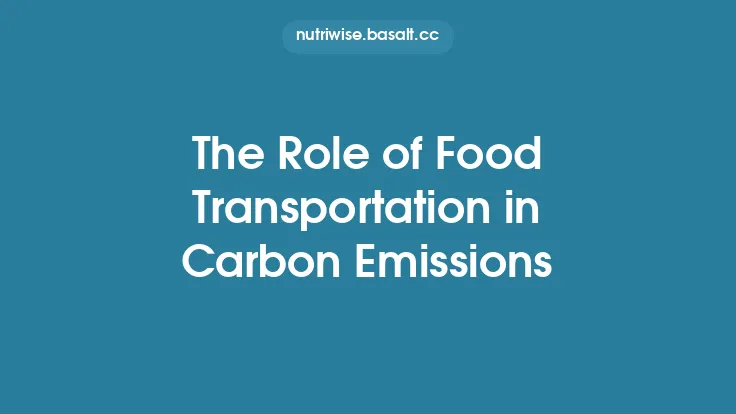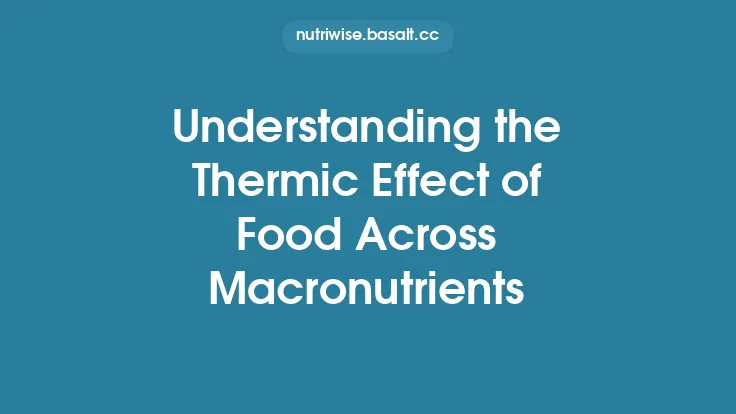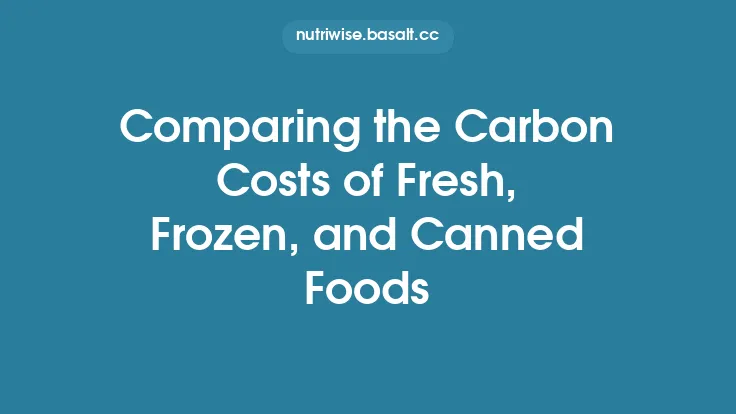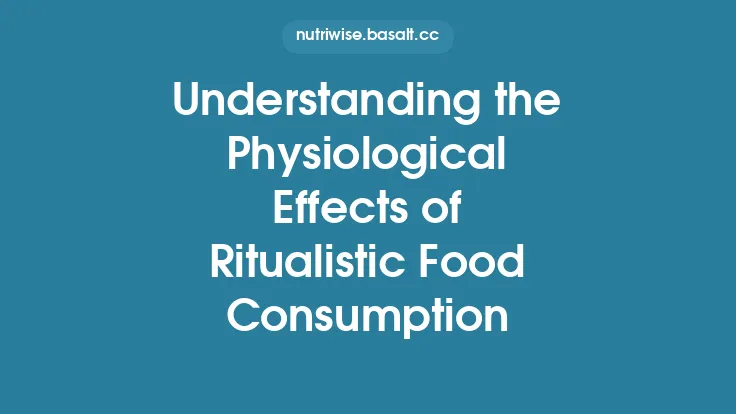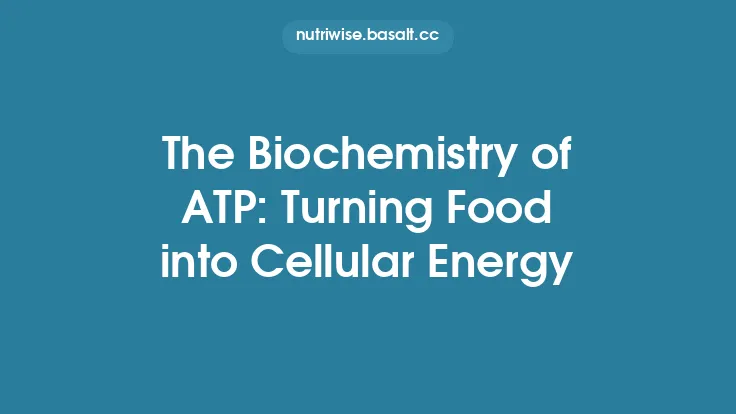Understanding the carbon footprint of the foods we eat is a cornerstone of sustainable and ethical eating. While many factors influence a product’s overall environmental impact, the production phase—encompassing everything from land use and feed conversion to fertilizer application and animal husbandry—accounts for the majority of greenhouse‑gas (GHG) emissions associated with most food groups. By breaking down these emissions by category, consumers can make more informed choices that align with climate‑friendly goals.
1. Meat and Poultry: The High‑Impact Tier
Why the emissions are high
- Enteric fermentation: Ruminants (cattle, sheep, goats) produce methane (CH₄) during digestion. Methane has a global warming potential (GWP) roughly 28‑34 times that of CO₂ over a 100‑year horizon, making it a potent contributor to the carbon footprint of beef and lamb.
- Feed conversion ratios (FCR): Producing 1 kg of beef typically requires 20‑25 kg of feed, whereas poultry needs about 2‑3 kg. The energy and land required to grow this feed translate directly into GHG emissions.
- Manure management: Decomposition of manure releases both methane and nitrous oxide (N₂O), the latter having a GWP about 298 times that of CO₂.
Typical emission ranges (kg CO₂‑eq per kilogram of edible product)
| Food | Emission Range |
|---|
| Beef (grass‑fed) | 27–36 |
| Beef (grain‑fed) | 22–30 |
| Lamb | 24–30 |
| Pork | 5–7 |
| Chicken (broiler) | 3–5 |
| Turkey | 4–6 |
Key take‑aways
- Red meat (beef, lamb) dominates the carbon footprint of animal‑based foods.
- Poultry and pork, while still higher than most plant‑based foods, are considerably lower‑impact alternatives within the meat category.
2. Dairy Products: A Mixed Profile
Sources of emissions
- Milk production: Similar to beef, dairy cows emit methane through enteric fermentation.
- Feed and land use: The feed required for dairy cows contributes to CO₂ emissions from fertilizer production and land conversion.
- Processing: Turning milk into cheese, butter, or yogurt adds energy‑intensive steps (e.g., pasteurization, aging).
Emission intensities (kg CO₂‑eq per kilogram of product)
| Product | Emission Range |
|---|
| Whole milk | 1.0–1.3 |
| Cheese (hard) | 8–12 |
| Yogurt (plain) | 1.5–2.0 |
| Butter | 11–13 |
| Powdered milk | 3–5 |
Insights
- Cheese and butter have the highest dairy‑related footprints because they concentrate the milk’s carbon intensity and require additional processing.
- Choosing lower‑fat dairy or plant‑based alternatives can reduce the per‑serving impact.
3. Eggs: A Moderately Low‑Impact Animal Product
Emission drivers
- Feed production: Chickens are efficient converters of feed to protein, with an FCR of roughly 2:1.
- Housing and energy: Large‑scale egg production uses electricity for lighting, ventilation, and temperature control, contributing to CO₂ emissions.
Typical values
- Whole egg (shell, raw): 2–3 kg CO₂‑eq per kilogram (≈ 0.2 kg CO₂‑eq per dozen large eggs).
Practical note
- Eggs provide high‑quality protein with a relatively modest carbon footprint compared to red meat, making them a favorable option for low‑impact animal protein.
4. Grains and Cereals: The Backbone of Global Calorie Supply
Why they are low‑impact
- High yields per hectare: Modern cereal crops (wheat, rice, maize) produce many tonnes of biomass on relatively small land areas.
- Low FCR: As plant foods, they do not require feed conversion, eliminating the methane and nitrous‑oxide pathways associated with livestock.
Emission ranges (kg CO₂‑eq per kilogram of dry weight)
| Crop | Emission Range |
|---|
| Wheat (bread) | 0.5–0.9 |
| Rice (paddy, milled) | 1.5–2.5 |
| Maize (sweet corn) | 0.6–1.0 |
| Barley (malt) | 0.7–1.1 |
| Oats (rolled) | 0.5–0.8 |
Special considerations
- Rice: Cultivated in flooded paddies, rice generates significant methane emissions, raising its footprint relative to other grains.
- Fertilizer use: Excess nitrogen fertilizer can lead to N₂O emissions; best‑practice management (e.g., precision application) can mitigate this.
5. Legumes and Pulses: High‑Protein, Low‑Carbon Powerhouses
Environmental advantages
- Nitrogen fixation: Legumes (beans, lentils, peas) host rhizobia bacteria that convert atmospheric N₂ into usable nitrogen, reducing the need for synthetic fertilizers.
- Low land intensity: They produce more protein per hectare than most animal sources.
Emission ranges (kg CO₂‑eq per kilogram of dry weight)
| Food | Emission Range |
|---|
| Lentils | 0.4–0.6 |
| Chickpeas | 0.5–0.7 |
| Black beans | 0.5–0.8 |
| Soybeans (edamame) | 0.8–1.2 |
| Peas (green) | 0.6–0.9 |
Key point
- Incorporating legumes into meals can dramatically lower the overall carbon intensity of a diet while delivering essential amino acids.
6. Nuts and Seeds: Nutrient‑Dense but Land‑Intensive
Carbon drivers
- Long growth periods: Many nut trees (e.g., almonds, walnuts) require several years to reach productive maturity, extending the carbon payback period.
- Water and irrigation: Certain nuts, especially almonds, have high water demands, which indirectly affect energy use for pumping and treatment.
- Processing: Shelling, roasting, and packaging add energy steps.
Emission ranges (kg CO₂‑eq per kilogram)
| Food | Emission Range |
|---|
| Almonds | 2.0–2.5 |
| Walnuts | 1.5–2.0 |
| Cashews | 1.8–2.3 |
| Sunflower seeds | 0.9–1.2 |
| Pumpkin seeds | 0.8–1.1 |
Interpretation
- While nuts are higher in carbon intensity than most grains or legumes, they still compare favorably to animal‑based proteins and provide healthy fats, fiber, and micronutrients.
7. Fruits and Vegetables: The Lowest‑Impact Food Groups
General characteristics
- High water use efficiency: Many fruit and vegetable crops produce large yields per unit of water and land.
- Minimal processing: Fresh produce typically requires only washing and sorting, which are low‑energy steps.
Emission ranges (kg CO₂‑eq per kilogram, fresh weight)
| Category | Emission Range |
|---|
| Leafy greens (spinach, lettuce) | 0.2–0.4 |
| Cruciferous veg (broccoli, cabbage) | 0.3–0.5 |
| Root veg (carrots, potatoes) | 0.2–0.4 |
| Tomatoes | 0.3–0.5 |
| Apples | 0.3–0.5 |
| Bananas | 0.4–0.6 |
| Citrus (oranges, lemons) | 0.4–0.6 |
Special notes
- Greenhouse-grown vegetables (e.g., tomatoes in heated glasshouses) can have higher footprints than field‑grown equivalents due to heating and lighting.
- Perennial fruit trees sequester carbon over their lifespan, partially offsetting emissions from cultivation.
8. Beverages: From Water to Coffee
Categories and emission drivers
- Water (bottled): Energy used in bottling, packaging, and distribution (though distribution is excluded from this article’s scope, the production of PET bottles still contributes).
- Coffee: Requires intensive processing (wet milling, roasting) and often involves high‑energy drying.
- Tea: Generally lower‑impact than coffee but still involves drying and packaging.
Emission ranges (kg CO₂‑eq per liter or kilogram of product)
| Beverage | Emission Range |
|---|
| Bottled water (plastic) | 0.3–0.5 |
| Coffee (ground, roasted) | 2.5–4.0 |
| Tea (black, dried) | 0.5–0.8 |
| Fruit juice (orange) | 0.6–0.9 |
| Wine (red) | 0.9–1.2 |
Takeaway
- Coffee stands out as one of the more carbon‑intensive beverages due to energy‑intensive processing steps. Opting for lower‑impact alternatives (e.g., tea) or sustainably certified coffee can reduce the footprint.
9. Comparative Overview: Visualizing the Spectrum
Below is a simplified hierarchy that places each food group on a relative carbon‑intensity scale (low → high). The numbers are illustrative averages; actual values vary by region, farming practice, and specific product type.
Very Low (≤0.5 kg CO₂‑eq/kg) → Leafy greens, most vegetables, most fruits, legumes
Low (0.5–1.5) → Grains, nuts (except almonds), dairy milk, eggs
Moderate (1.5–3) → Poultry, pork, cheese, nuts (almonds, walnuts), coffee
High (>3) → Beef, lamb, butter, some rice, processed dairy
Understanding where a food sits on this spectrum helps prioritize swaps that yield the greatest climate benefit.
10. Factors That Modulate the Carbon Footprint Within Each Group
Even within a single food group, production methods can cause wide variation. The following variables are the most influential:
| Variable | How it Alters Emissions |
|---|
| Feed source (for animal products) | Grass‑fed beef often has higher land‑use emissions but lower feed‑lot methane; grain‑fed systems may reduce land use but increase fertilizer‑related N₂O. |
| Fertilizer intensity (for crops) | Excess nitrogen leads to N₂O emissions; precision agriculture can cut these by 10‑30 %. |
| Crop rotation & cover cropping | Improves soil carbon sequestration, offsetting a portion of emissions. |
| Manure management | Anaerobic lagoons produce methane; aerobic composting reduces it. |
| Energy source for processing | Facilities powered by renewable electricity lower the carbon intensity of processed foods (e.g., cheese aging, coffee roasting). |
| Yield per hectare | Higher yields dilute the per‑kilogram emissions, making intensive but efficient systems sometimes less carbon‑intensive than extensive low‑yield farms. |
11. Practical Implications for Sustainable Eating
- Prioritize plant‑based proteins – legumes, beans, and pulses deliver protein with the smallest carbon footprint.
- Choose poultry or pork over red meat – if animal protein is desired, these options are markedly lower in emissions.
- Select low‑impact dairy – milk and yogurt are modest, but cheese and butter should be consumed sparingly.
- Incorporate a variety of fruits and vegetables – they consistently rank among the lowest‑impact foods.
- Be mindful of high‑impact nuts and coffee – enjoy them in moderation or seek certifications that indicate sustainable production practices.
12. Looking Ahead: Emerging Trends in Food‑Group Carbon Accounting
- Life‑Cycle Assessment (LCA) standardization: International bodies are working toward harmonized LCA methodologies, which will improve comparability across studies.
- Carbon labeling: Some jurisdictions are piloting mandatory carbon‑footprint labels on packaged foods, giving shoppers direct insight into group‑level impacts.
- Alternative proteins: Cultivated meat and precision‑fermented dairy aim to replicate high‑impact animal foods with dramatically lower emissions, potentially reshaping the carbon hierarchy of food groups.
13. Concluding Thoughts
The carbon footprint of food is not a monolith; it varies dramatically across food groups and even within each group depending on production practices. By understanding the underlying drivers—methane from ruminants, fertilizer‑related nitrous oxide, energy‑intensive processing, and land‑use change—consumers can make evidence‑based choices that reduce their dietary climate impact. While no single food group is entirely “carbon‑free,” shifting the overall composition of the diet toward lower‑impact categories—especially legumes, grains, and a wide array of fruits and vegetables—offers a clear pathway toward a more sustainable food system.
